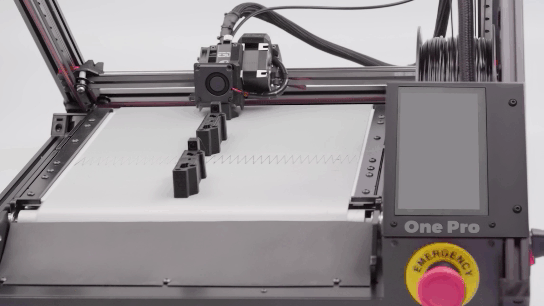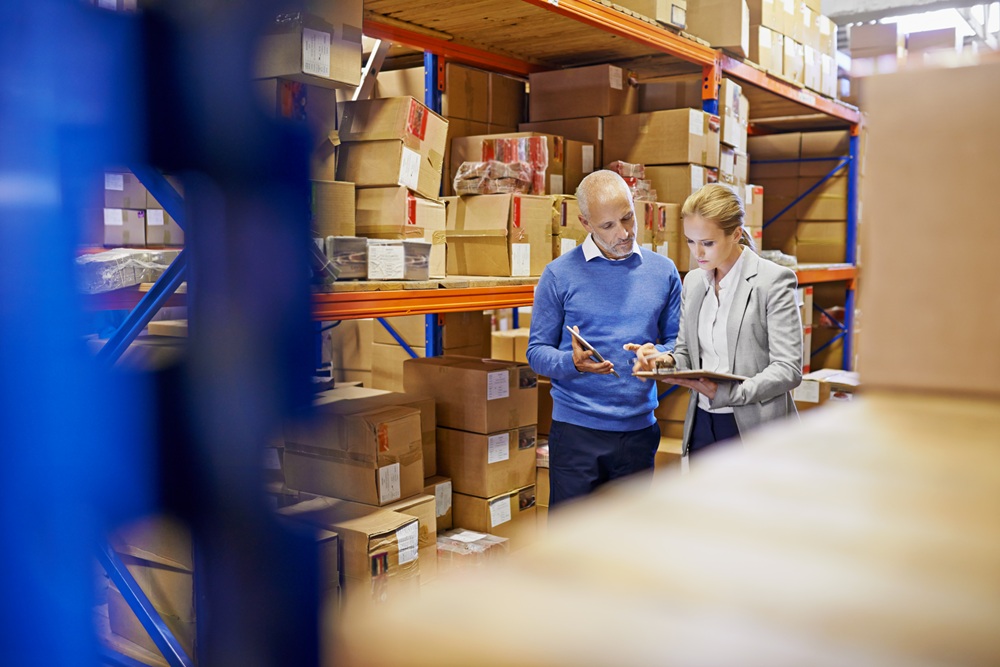From Digital Design to Ready-to-Ship Product
What if you could not only design an idea, but produce it ready for series production, package it, and send it directly to the largest online marketplaces in the shortest possible time – without your own warehouse, without a production hall, without complex logistics? This is exactly what’s possible today. With the help of 3D printing, automated production, and Amazon FBA (Fulfillment by Amazon) infrastructure, companies can not only test new product ideas, but build entire sales channels – flexible, scalable, and without large capital investment.
iFactory3D shows how companies in the B2B sector use this groundbreaking combination of additive manufacturing and digital commerce to open up new markets and bring products to end customers faster than ever before. Whether it’s design-oriented small series, functional everyday solutions, or specific technical components: the connection between on-demand 3D printing and automated fulfillment logistics is now a central building block for entrepreneurial success in e-commerce.
The Basics – What is Amazon FBA and Why is it So Powerful?
Amazon FBA is more than just a storage service – it’s a fully automated system for storing, picking, packing, shipping, and even customer service for products you sell on Amazon. As a seller, you send your products to one of Amazon’s logistics centers. From there, Amazon takes over all further tasks: as soon as a customer orders, the product is automatically shipped – within the shortest time, often even on the same day.
This system offers several advantages for companies: You don’t need your own warehouse or logistics staff. You benefit from Amazon’s enormous reach and customer trust. You can focus entirely on product development and marketing.
Why 3D Printing Fits Perfectly with FBA
While traditional manufacturing – such as injection molding – brings long lead times, high tooling costs, and large minimum quantities, 3D printers allow a completely new type of production: on-demand, scalable, and customizable. The full potential unfolds especially in combination with Amazon FBA: small series without risk, fast time-to-market, and product diversity without overhead.
The result: A completely digital value chain where ideas are seamlessly transformed into physical products that are on Amazon’s shelves within the shortest time.
From Marketplace to Your Own Shop: Sales Channels Overview
The central question of many companies that want to sell their own products is: Where should I sell? The answer to this is more diverse than ever today – and therein lies the great opportunity. In addition to Amazon, which is particularly attractive through FBA, there are a variety of other platforms and sales channels that companies can use specifically: Kaufland.de, eBay, Shopify, and WordPress with WooCommerce.
The combination of marketplaces (reach) and own shops (brand building and control) is often the best way. And this is where iFactory3D comes into play: with a fully digitized production process, products can be prepared specifically for each sales channel – including packaging, labeling, and shipping preparation.
What Are You Selling – and Why is 3D Printing a Game Changer?
Many companies know what they want to offer – but not whether it can be produced economically. This is exactly where 3D printing with iFactory3D makes a difference: through flexible production processes, even unusual or complex products can be quickly realized, tested, and iteratively improved.
Some product types that are particularly suitable: functional household solutions, design products and decorative objects with high individualization, technical components where conventional manufacturing costs would be too high, and small series and limited editions. In practice, this means: you can start with a single prototype – and if it sells, iFactory3D immediately takes over series production, including FBA handling.
Production, Packaging, Shipping: Everything from One Source
The requirements in e-commerce are clear: products must not only be high-quality, but also efficiently packaged, correctly labeled, and arrive on time at the fulfillment service provider’s warehouse. This is exactly what iFactory3D takes over as a B2B service provider – completely in-house.
Through the use of continuously operating 3D printers, not only is higher production capacity achieved, but also extensive automation is enabled. This means: series productions run overnight, components fall directly from the print bed to the output belt and are then packaged. But that’s not all: iFactory3D also takes care of preparation for Amazon FBA – including EAN labeling, barcode generation, FBA-compliant packaging, and direct shipping to Amazon warehouses or other fulfillment centers.
Success Example 1: Custom Designer Lamp for Online Sales
A customer from the interior sector came to iFactory3D with a design idea: a sculptural lamp, filigree, light, and precisely adjusted to specific dimensions. The goal was online sales via Shopify and eBay. After a brief CAD alignment, the product was manufactured in an initial small series of 200 pieces. The lamps were packaged, provided with individual labels, and forwarded to Amazon’s FBA warehouses and other fulfillment service providers. Thanks to precise 3D printing technology, complex geometric shapes could be realized that would not have been feasible with conventional manufacturing processes. The customer benefited from significantly reduced lead times and could enter the market directly without high tooling costs.
Success Example 2: Universal Quark Lids for Amazon
A customer wanted to offer a simple but ingenious everyday product on Amazon: reusable quark lids for opened food cans. The special feature: the lid had to fit different can sizes and still sit firmly – a challenge that would have been too expensive with injection molding.
iFactory3D developed the final geometry together with the customer, produced the first test series, and then took over the entire process: from series printing to FBA-compliant individual packaging with labeling and Amazon shipping logistics. Today, the quark lid sells directly via Amazon.de – with excellent customer feedback and minimal effort for the provider.
Success Example 3: Roof Access Clips – When Injection Molding Doesn’t Pay Off
Another example comes from the technical sector: a crafts business needed high-strength clips for securing walkways on metal roofs. The annual production quantity was too small for the costly tool construction in injection molding – and the products had to be regularly revised, for example with changes to the roof system.
iFactory3D developed a function-optimized version together with the customer and implemented production in intervals – as needed. The advantages for the customer were obvious: no investment in tools, flexible delivery quantities, possibility for constant product optimization, and ready-to-ship packaging for online trading. Thus, a niche need became a scalable product for specialized trade that is now regularly reproduced.
Analyzing Product Ideas and Market Potential
Before implementation begins, a central question arises: What exactly do you want to sell – and for whom? Many companies have innovative product ideas or even possess existing designs that are not yet marketed. 3D printing allows these ideas to become reality without high initial investments.
Typical starting points are spare parts or technical components for existing customers, special solutions for niche markets, design or lifestyle products that convince through individuality, and test products that could potentially later be replaced by injection molding. A well-founded keyword research on Google or Amazon helps assess market demand. Tools like Helium10 or Jungle Scout also provide insight into market volume, competitive situation, and price points – ideal for product development.
Choosing Suitable Platforms and Sales Channels
Depending on product type and target group, different platforms are suitable. The choice of the right channels determines visibility, sales potential, and brand perception: Amazon FBA is quickly scalable and ideal for high-volume products; eBay is flexible and suitable for test markets; Kaufland.de is an alternative to Amazon, often with less competition; Shopify or WooCommerce are perfect for brand building and long-term customer loyalty.
Outsourcing Production and Fulfillment – But Correctly
One of the biggest mistakes when starting in e-commerce is underestimating logistics and operational processes. Companies that want to sell 3D products quickly face questions like: How do I package the product safely for transport? What labels does Amazon or Kaufland need? How quickly can I reproduce if demand increases?
With a partner like iFactory3D, these challenges can be systematically solved: on-demand production with consistent quality, standardized packaging and labeling according to FBA specifications, scalable series production as soon as a product is successful, and direct shipping to Amazon, DHL Fulfillment, or own warehouses. This creates a lean, efficient business model – without investments in machines, personnel, or storage space.
The Future Belongs to Flexible Production
One thing is clear: the way products are developed, manufactured, and sold has fundamentally changed through 3D printing and automated fulfillment processes. Companies that rely on these technologies early today secure decisive competitive advantages: speed beats size, individualization becomes standard, warehouse-free business reduces costs, and sustainability becomes a success factor.
All this shows: the path to a modern, efficient e-commerce business doesn’t have to be capital-intensive or risky. With partners like iFactory3D, a complete digital production chain can be built – from idea to market-ready product, fully integrated into existing sales channels.
iFactory3D as Partner for Scalable Growth in E-Commerce
As an innovation leader in 3D printing, iFactory3D is more than just a production service provider. The company supports its B2B customers holistically – from design optimization through series production to ready-to-ship product handover to Amazon FBA, Shopify, eBay, or Kaufland.
The practical examples in this article – from the designer lamp to the quark lid – impressively show how different and yet efficient the use of 3D printing in e-commerce can be. Especially in the B2B sector, where custom manufacturing, flexible series, and technical know-how are in demand, iFactory3D proves to be a strong partner for future-oriented business models.
Your Next Step: From Concept to Revenue
Whether you already have a concrete product idea or your company is still looking for new digital business models – entering 3D-based e-commerce has never been easier.
Questions you should ask yourself today: Are there products in your range that could be individualized or improved? Which parts of your logistics process could you outsource? Which markets could you quickly test with small quantities? Those who find the right answers here – and implement them with partners like iFactory3D – create a real advantage in an increasingly digital trading world.
Reading Tip
Those who want to dive deeper into the topic “3D printing for e-commerce” will find further information, examples, and contact options directly on the iFactory3D website.
 Serial production
Serial production
